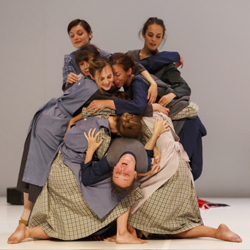
“Please, don’t forget to take earplugs”—the girl with a tray of small blue things made me feel nervous even before Four Seasons by Romeo Castellucci started. However, the aural risk didn’t scare off Berliners and tourists alike – the show was entirely sold out.
Castellucci is originally from Italy but has created most of his performances in Avignon, France. As a result, he has been well-known and widely discussed for more than 10 years in these regions. As a follower of Antonin Artaud and his “Theatre of Cruelty,” Castellucci produces an eclectic mix of Greek dramatic plots, contemporary visual arts, technical installations, and revolting naturalism.
His Four Seasons is an homage to American artist Mark Rothko, who withdrew his paintings (totaling a surface of 600 square feet) that were originally meant to decorate the fashionable Four Seasons restaurant in 1958. Rothko returned the money to the Four Seasons and let the paintings live a solitary life until they were later exhibited in the Tate Modern Gallery.
The main idea of the play is artistic refusal and the gradual disappearance of everything material.
In the very first minute the theater is plunged into darkness and a heavy, loud sound fills the space. My heart started pounding in unison with the sounds and I reflexively reached for the earplugs… however I stopped halfway so as to hear the sound pure as it was.
A black screen on the stage began to show technical information and numbers – according to it, the sound was that of a supermassive black hole (nothing to do with Muse) recorded by NASA. German-speaking students were kind enough to translate the challenging text to their colleagues sitting nearby, while others from the group just had to rely on their intuition.
In a few moments we found ourselves in a foggy gym. Now in total silence, a girl in an Amish-style dress entered the stage, picked up a pair of nail scissors, pulled out her tongue and diligently cut it with tears and sobs. In a resolute movement, she dropped the scissors together with a small piece of something pink, immediately covering her mouth with both hands.
As the first girl moved to the right part of the stage, nine other girls followed, cyclically repeating the same pattern – scissors, tongue, tears, drop. Those who went through the procedure formed a circle by holding hands. The scene ended quite unpredictably – while the stage sank into gloom, a real black dog started eating the “tongues,” amusing the audience.
Castellucci used a non-trained dog, which he considers to be “the monarch of the stage in a positive sense as it owns the space and sets the rules.” According to the director, if the dog decided to stay on stage for an hour, everyone would have to wait. This time we were fortunate enough.
The curtain in Four Seasons plays an important separating part between elements of the play which don’t seem to be connected at all. After the dog triumph, the curtain falls and rises, revealing the ten Botticelli-like girls doing random posture études and reciting (tongues are back in working order!) extracts from Death of Empedocles by Friedrich Hölderlin. Castellucc
The girls proceeded to pass around a golden crown, play with Kalashnikovs, die and resurrect in some symbolic acts. At the end of the epic part, the girls gave birth to one another, symbolically squeezing one by one through the embracing arms of the others, then shedding their clothing and leaving the stage absolutely naked, in a reverse order compared to the beginning, until the stage was empty.
The performance continued to increase in absurdity. Snap – and there is a huge dead horse on the stage. Snap – and the text on the screen demands you not to forget. Another snap – bright flashes of light destroy your eyes, sound gets louder, but curiosity overcomes the feeling of physical pain and you keep looking at the stage.
Castellucci skillfully mixes sounds, colours, pictures, texts and other different visual media. Music deserves special attention – the original sounds were created by Scott Gibbons, who worked with numerous performances by Castellucci and his Socìetas Raffaello Sanzio. The composer mixes sounds from nature with electro-acoustic tunes, which reach not only to the ears, but to the whole body, waking up some ancient instincts inside.
The performance culminated in the screening of a volcano eruption, which probably alluded to Etna. It burst into millions of ashes that resembled little ghosts. It looked as if nature was in a rage: explosions and lightning accompanied by loud music reached a peak. At the end, we saw a person waving a huge flag, on the background of the portrait of a mysterious lady, who later turned out to be a New Orleans prostitute.
The Italian director often refuses to answer particular questions about his concepts and ideas. He makes the audience curious, but doesn’t give any clue regarding the reason or the meaning of an analogy. Even though I attended a Q&A session after the play, I went out with a strong feeling: it’s up to me to create in my mind a solid personal picture of the numerous layers, pieces and snaps that Romeo Castellucci suggested to us that night.
